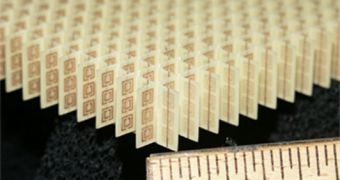Scientists working to innovate the field of nanotechnology are arguing that, in the near future, nanomachines – as in small robots capable of operations at the nanoscale – will undoubtedly be used to fix our bodies, in the hospitals, in the military, and in space exploration. They say that one of the main things stopping further progress in this issue is the fact that, even if the technology existed to construct such small components, then the machines wouldn't work because of the strong mechanical friction. Now, researchers at the US Department of Energy's (DOE) Ames Laboratory have devised a method of eliminating this friction and allowing for the field to progress.
What the team essentially did was discover a new way of manipulating the famous Casimir forces, through the use of a new generation of materials that have very bizarre physical and chemical properties, called metamaterials. In its new work, which relied entirely on theoretical mathematical calculations, the Ames group determined that, by placing certain types of metamaterials in very close proximity to each other, they would obtain repulsive forces strong enough to ensure that no friction occurred between the nanoscale components.
Details of the work appear in the paper entitled “Repulsive Casimir Force in Chiral Metamaterials,” which is published in the September 4 issue of the respected scientific journal Physical Review Letters. The research was conducted by Iowa State University Distinguished Professor of Physics Costas Soukoulis, who is also a senior physicist at the Ames Lab. He explains that Casimir forces were first hypothesized in 1948 by Dutch physicist Hendrik Casimir. He said that, even in vacuum, two small objects brought close together would exhibit attraction or rejection between them.
Since, most instances in which these forces have been observed have been of the attractive kind, physicists say. Because of this, they have always made nanoscale and microscale materials clump together, essentially rendering all small machines and robots nonoperational. The new investigation shows that the obstacle can be overcome through the use of chiral metamaterials, which have a unique property – their molecular structure prevents them from being superimposed over a reverse copy of themselves. This is obvious in the case of a human hand, which never fits perfectly onto a reverse copy of itself.
“With natural materials you have to take what nature gives you; with metamaterials, you can create a material to exactly meet your requirements,” Ames Laboratory assistant scientist Thomas Koschny says. The new work was only done theoretically because existing semiconductor lithographic techniques do not allow for the creation of the actual required metamaterials just yet, the group concludes.

 14 DAY TRIAL //
14 DAY TRIAL //